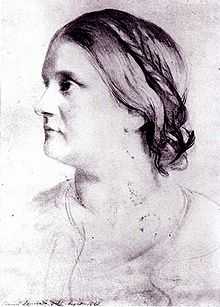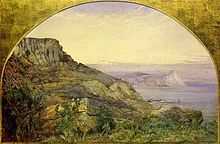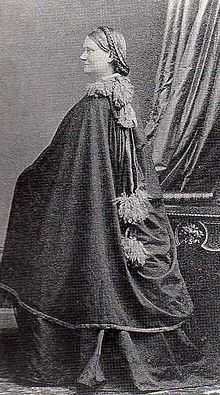Barbara Bodichon
| Barbara Bodichon | |
|---|---|
 Barbara Bodichon portrait by Samuel Lawrence | |
| Born |
Barbara Leigh Smith 8 April 1827 Carlton Crescent, Southampton |
| Died | 11 June 1891 (aged 64) |
| Nationality | British |
| Known for | founder Girton College, Cambridge |
Barbara Leigh Smith Bodichon (8 April 1827 – 11 June 1891) was an English educationalist, artist, and a leading mid nineteenth-century feminist and activist for women's rights.
Early life
She was the extramarital child of Anne Longden, a milliner from Alfreton, and the Whig politician Benjamin (Ben) Leigh Smith (1783–1860), the only son of the Radical abolitionist William Smith. Benjamin had four sisters. One, Frances (Fanny) Smith, married William Nightingale (ne Shore) and produced a daughter, Florence, the nurse and statistician; another married into the Bonham Carter family. Ben's father wanted him to marry Mary Shore, the sister of William Nightingale, now a relative by marriage.
Ben Smith's home was in Marylebone, London, but from 1816 he inherited and purchased property near Hastings: Brown's Farm near Robertsbridge, with a house built around 1700 (extant), and Crowham Manor, Westfield, which included 200 acres (0.81 km2). Although a member of the landed gentry, Smith held radical views. He was a Dissenter, a Unitarian, a supporter of free trade, and a benefactor to the poor. In 1826 he bore the cost of building a school for the inner city poor at Vincent Square, Westminster, and paid a penny a week towards the fees for each child, the same amount as paid by their parents.[1]
On a visit to his sister in Derbyshire in 1826, Smith met Anne Longden. She became pregnant by Smith and he took her to a rented lodge at Whatlington, a small village near Battle, East Sussex. There she lived as "Mrs Leigh", the surname of Ben Smith's relations on the nearby Isle of Wight. Barbara's birth created a scandal because the couple did not marry; illegitimacy carried a heavy social stigma. Smith rode from Brown's Farm to visit them daily, and within eight weeks Anne was pregnant again. When their son Ben was born, the four of them went to America for two years, during which time another child was conceived.
On their return to Sussex they lived openly together at Brown's and had two more children. After their last child was born in 1833, Anne became ill with tuberculosis and Smith leased 9 Pelham Crescent, which faced the sea at Hastings; the healthy properties of sea air were highly regarded at the time. A local woman, Hannah Walker, was employed to look after the children. Anne did not recover, so Smith took her to Ryde, Isle of Wight, where she died in 1834. Barbara was only seven years old.
Later life

Early on, she showed a force of character and catholicity of sympathy that later won her a prominent place among philanthropists and social workers. She and a group of friends began to meet regularly during the 1850s in Langham Place in London to discuss women's rights, and became known as "The Ladies of Langham Place". This became one of the first organised women's movements in Britain. They pursued many causes vigorously, including their Married Women's Property Committee. In 1854, she published her Brief Summary of the Laws of England concerning Women,[2] which had a useful effect in helping forward the passage of the Married Women's Property Act 1882. During this period she became close friends with the artist Anna Mary Howitt, for whom she sat on several occasions.[3]
In 1857, she married an eminent French physician, Dr. Eugène Bodichon, and, although wintering many years in Algiers, continued to lead the movements she had initiated in behalf of Englishwomen.[4]

In 1858, she set up the English Women's Journal as an organ for discussing employment and equality issues directly concerning women, in particular manual or intellectual industrial employment, expansion of employment opportunities, and the reform of laws pertaining to the sexes.
In 1866, co-operating with Emily Davies, she matured a scheme for the extension of university education to women, and the first small experiment at Hitchin developed into Girton College, Cambridge, to which Madame Bodichon gave liberally of her time and money.[4]
With all her public interests she found time for society and her favourite art of painting. She studied under William Holman Hunt, and her water-colors, exhibited at the Salon, the Royal Academy and elsewhere, showed great originality and talent, and were admired by Corot and Daubigny. Her London salon included many of the literary and artistic celebrities of her day; she was George Eliot's most intimate friend, and, according to her, the first to recognise the authorship of Adam Bede. Her personal appearance is said to be described in that of Romola. Madame Bodichon died at Robertsbridge, Sussex, on 11 June 1891.[4]
She was a Unitarian who wrote of Theodore Parker: He prayed to the Creator, the infinite Mother of us all (always using Mother instead of Father in this prayer). It was the prayer of all I ever heard in my life which was the truest to my individual soul. (Lingwood, 2008)
Refurbishment of her grave
In 2007, the British equal rights campaigner and feminist Lesley Abdela came across the grave of Barbara Bodichon. The grave lay in the tiny churchyard in Brightling, East Sussex, about 50 miles (80 km) from London, in a state of disrepair, its railings rusted and breaking away and the inscription on the tomb almost illegible.[5] The historian Dr Judith Rowbotham at Nottingham Trent University issued an appeal for funds to restore the grave and its surrounds. About £1,000 was raised and under the eye of Mrs Irene Baker, Secretary, Brightling Parochial Church Council this has now been used to sand-blast the railings and repaint them, and clean the granite tomb. The grave and its surrounds are now in very good, attractive order, as they must have been over a century ago.
See also
- History of feminism
- Women's suffrage in the United Kingdom
- List of Unitarians, Universalists, and Unitarian Universalists
- English women painters from the early 19th century who exhibited at the Royal Academy of Art
- Sophie Gengembre Anderson
- Mary Baker
- Ann Charlotte Bartholomew
- Maria Bell
- Joanna Mary Boyce
- Margaret Sarah Carpenter
- Fanny Corbaux
- Rosa Corder
- Mary Ellen Edwards
- Harriet Gouldsmith
- Mary Harrison (artist)
- Jane Benham Hay
- Anna Mary Howitt
- Mary Moser
- Martha Darley Mutrie
- Ann Mary Newton
- Emily Mary Osborn
- Kate Perugini
- Louise Rayner
- Ellen Sharples
- Rolinda Sharples
- Rebecca Solomon
- Elizabeth Emma Soyer
- Isabelle de Steiger
- Henrietta Ward
References
- ↑ Helena Wojtczak. "Barbara Leigh Smith Bodichon: The Hastings Connections". Hastings Press.
- ↑ Brief Summary of the Laws of England concerning Women
- ↑ Hirsch, Pam (Jan 2011) [2004]. "Howitt [Watts], Anna Mary (1824–1884)". Oxford Dictionary of National Biography. Oxford University Press. Retrieved 9 July 2011.
- ↑ 4.0 4.1 4.2 Chisholm 1911.
- ↑ Campaigner's tomb appeal launched at BBC News Online
- Attribution
 This article incorporates text from a publication now in the public domain: Chisholm, Hugh, ed. (1911). "Bodichon, Barbara Leigh Smith". Encyclopædia Britannica (11th ed.). Cambridge University Press.
This article incorporates text from a publication now in the public domain: Chisholm, Hugh, ed. (1911). "Bodichon, Barbara Leigh Smith". Encyclopædia Britannica (11th ed.). Cambridge University Press.
Further reading
- Herstein, Sheila R. (1985). A mid-Victorian feminist, Barbara Leigh Smith Bodichon. New Haven: Yale University Press. ISBN 0-300-03317-6.
- Hirsch, Pamela (1998). Barbara Leigh Smith Bodichon: Feminist, Artist and Rebel. London: Chatto & Windus. ISBN 0-7011-6797-1.
- Lingwood, Stephen (2008). The Unitarian Life: Voices from the Past and Present. London: Lindsey Press. ISBN 978-0-85319-076-9.
- Marsh, Jan; Gerrish Nunn, Pamela (1998). Pre-Raphaelite Women Artists. London: Thames & Hudson. ISBN 0-500-28104-1.
- Matthews, Jacquie. Barbara Bodichon: Integrity in diversity (1827–1891) in Spender, Dale (ed.) Feminist theorists: Three centuries of key women thinkers, Pantheon 1983, pp. 90–123 ISBN 0-394-53438-7
External links
- Hastings Press bio of Bodichon
- Barbara Bodichon
- Girton College Cambridge: Personal Papers of Barbara Leigh Smith Bodichon
- Excerpts from an American Diary
- The Victorian web: Barbara Leigh Smith (Madame Bodichon) and Hastings
|